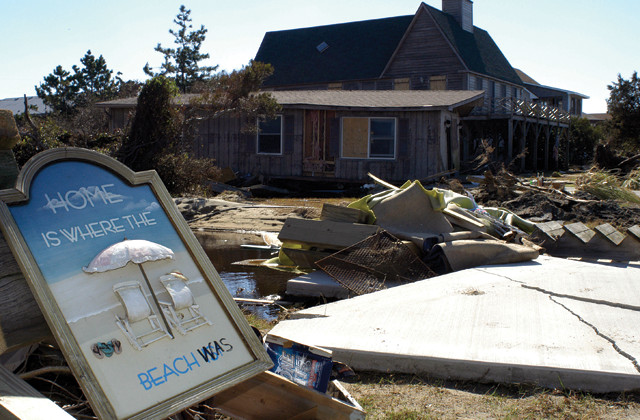
by Mary Caperton Morton Tuesday, March 19, 2019

Debris from a damaged house in Hatteras, N.C., lies strewn on the ground after Hurricane Isabel hit the area in September 2003. Credit: Cynthia Hunter/FEMA.
When it comes to houses in the U.S., bigger is often seen as better. A new study looking at the recovery of real estate after major hurricanes has found that this trend also applies to beach houses rebuilt in vulnerable locations after damaging storms.
Using before and after satellite imagery of coastal communities hit by hurricanes between 2003 and 2012, a team led by Eli Lazarus of the University of Southampton in England demonstrated a trend of “building back bigger” in coastal zones known to be at risk from extreme winds and storm surges. “This practice intensifies risk by exposing increasingly high-value property to repeated damage,” he says. “This in turn puts a greater strain on the funding of subsidized insurance programs for properties in at-risk areas.”
The study, published in Nature Sustainability, focused on beach communities located on developed barrier islands and beaches in five states on the U.S. East and Gulf coasts, including Mantoloking, N.J., Hatteras and Frisco, N.C., Santa Rosa Island, Fla., Dauphin Island, Ala., and Bolivar, Texas. “We tried to set up a spectrum of beach communities, in different states, with different socioeconomic settings, all subjected to different local planning rules, all damaged by different storms,” he says. “The fact that there’s this systematic pattern of building back bigger despite local variations tells us … how powerful this pattern really is.”
By comparing the footprints of single-family residences before and after six major storms struck the various beach towns, Lazarus and his colleagues showed an overall trend of larger homes replacing smaller ones across all five locations. The increases ranged from 19 percent bigger on average in Hatteras after Hurricane Isabel in 2003 to 49 percent larger on average on Santa Rosa Island after Hurricane Ivan in 2004. Lazarus notes that houses in the U.S. are getting bigger in general — between 2002 and 2016, the mean size of newly built single-family homes increased by 16 percent — but the increases reported in the study are larger than the nationwide average.
The study also highlights the issue of formerly working-class beach towns being bought out and developed in the wake of storms, says Dylan McNamara, a coastal oceanographer at the University of North Carolina Wilmington who was not involved in the new study. “The more socioeconomically vulnerable a community is, the longer it takes to recover in the wake of disaster. Some places never recover,” McNamara says. “When families who have lived in a place for generations can’t afford to rebuild, they tend to get bought out by investors,” who put up larger and more expensive structures.
The building-back-bigger trend is in line with federally subsidized insurance programs and beach erosion mitigation efforts that have propped up the market for years and allowed more development in coastal zones, McNamara says. Having high-value properties being built right on the edge of eroding and storm-affected coastlines “is very financially precarious,” he says, and it’s an issue that’s not going away, especially as storms get stronger and sea levels rise.
New measures to slow or reverse the trend of building back bigger could include reforming tax and insurance options available to property owners in high-risk zones. “When a house is built on sand,” McNamara says, “you can only prop it up for so long before it falls into the sea.”
© 2008-2021. All rights reserved. Any copying, redistribution or retransmission of any of the contents of this service without the expressed written permission of the American Geosciences Institute is expressly prohibited. Click here for all copyright requests.